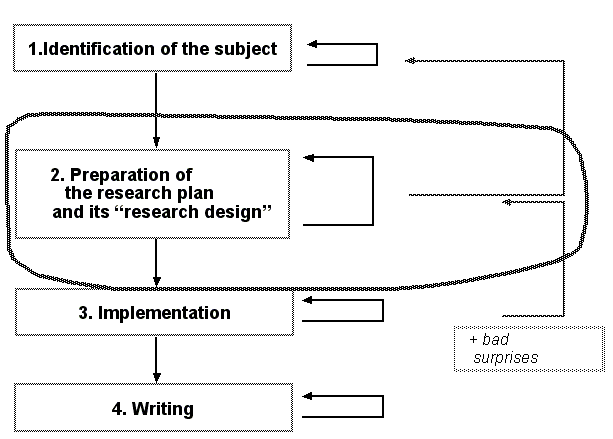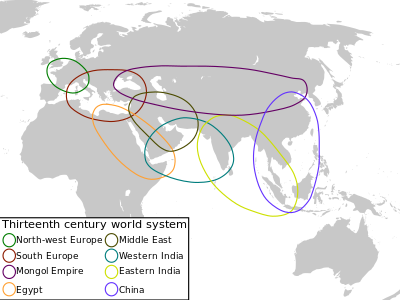Outlining a research plan implicating elements of the perspective
VI.Action Plan: Outlining a research plan implicating elements of the perspective
This unit is utilized to promote group work intended to develop tentative ideas which link up the
world-system perspective and its variants with group research agendas. It is expected that the
‘linkaging’ carried out in the preceding unit will provide valuable inputs for the preparation of
group research agendas.
### VI. Action Plan: Outlining a Research Plan Using the World-System Perspective
This unit aims to guide students in formulating a **research plan** that incorporates the key elements of the **world-system perspective** and its variants. Building on the theoretical linkages discussed in the previous unit, the objective is to develop group research agendas that explore **global-local dynamics**, applying world-system theory to specific **empirical cases** relevant to Nepal or other regions of interest.
#### 1. **Defining the Research Objective**
The first step in developing a research plan is to clearly define the **research objective**. The group should collectively decide on a specific **sociological issue** or **phenomenon** that they want to explore using the **world-system perspective** as a theoretical framework. This issue could relate to:
- **Economic dependency** and the role of **remittances** in shaping local economies.
- The impact of **globalization** on **labor migration** and **employment patterns** in Nepal.
- The influence of **global trade** on **agrarian structures** and **class dynamics** in rural Nepal.
- Analyzing **Nepal's peripheral status** and its political and economic relationship with **core nations**.
- Understanding the role of **international institutions** (e.g., World Bank, IMF) in shaping **national policies**.
Once the group has selected an issue, they can begin crafting a research **question** or **hypothesis** that connects the world-system perspective to the local context. For example, one might ask, *"How does Nepal's position in the periphery of the world-system affect its reliance on foreign remittances for economic stability?"* or *"What role do international trade agreements play in reinforcing class inequalities in rural agricultural communities?"*
#### 2. **Reviewing Literature**
The next step involves conducting a **literature review**. Drawing from both **world-system theory** and **local texts** (such as those discussed in the **Colloquium on Nepal**), students should gather academic resources, articles, books, and case studies that provide insights into their research question.
For example:
- **Wallerstein’s core-periphery model** and its application in peripheral economies like Nepal.
- **Dependency theory** and critiques from scholars such as **Andre Gunder Frank**, **Chaitanya Mishra**, or **Theda Skocpol**.
- Empirical studies on **labor migration**, **agrarian economies**, or **global commodity chains** in peripheral nations.
This literature will serve as the foundation for the theoretical framework and inform the group’s understanding of both **global structural forces** and **local specificities**.
#### 3. **Developing Research Methodology**
The next stage involves outlining a **research methodology**. The group should decide which **methods** will be most appropriate for collecting and analyzing data. Possible methods include:
- **Qualitative Methods**:
- **Interviews** with migrant workers, agricultural laborers, or local businesses to understand how global economic forces impact their livelihoods.
- **Focus groups** with community members affected by foreign aid, remittances, or international trade policies.
- **Ethnographic fieldwork** to observe the dynamics of rural or urban communities and their integration into global markets.
- **Quantitative Methods**:
- **Surveys** to gather statistical data on remittance flows, income inequality, or employment patterns among migrant laborers.
- **Data analysis** of economic indicators such as GDP, trade deficits, or remittance contributions to the national economy, which can highlight Nepal’s dependent position in the world economy.
- **Case Studies**:
- Focus on specific regions (e.g., rural villages affected by cardamom cultivation or migrant-heavy districts) to explore local-global linkages in detail.
- **Comparative analysis** of Nepal with other peripheral nations, drawing parallels and differences in how global capitalism shapes development outcomes.
#### 4. **Linking Theory and Data**
In this stage, students should focus on **linking the theoretical framework**—the world-system perspective—with the **empirical data** they plan to collect. The key here is to use **Wallerstein’s concepts** of core, periphery, and semi-periphery, as well as the **criticisms** and **variants** of the theory, to interpret the data and draw meaningful conclusions.
For example:
- If the group is studying labor migration, they might analyze how the **core countries** (Gulf states, Malaysia) extract cheap labor from **peripheral countries** like Nepal, and how this dynamic impacts local economic stability and social structures.
- If the focus is on agriculture, the group can explore how **global commodity chains** (e.g., in the cardamom industry) integrate local farmers into global markets while maintaining unequal terms of trade, as per the **dependency theory** framework.
By continuously referencing **world-system theory** and its variants throughout the data collection and analysis process, the group will ensure that their research is grounded in the theoretical concepts they have learned.
#### 5. **Organizing Group Work**
Each group should assign specific **tasks** and **roles** to members to ensure efficient collaboration. Possible roles include:
- **Research Coordinator**: Oversees the progress of the research, ensuring deadlines are met and the methodology is followed.
- **Literature Review Lead**: Gathers and organizes relevant theoretical and empirical literature.
- **Fieldwork/Survey Lead**: Manages data collection, including designing surveys or organizing interviews.
- **Data Analyst**: Analyzes quantitative or qualitative data collected during the research process.
- **Writer/Editor**: Drafts the research paper, ensuring it integrates theoretical and empirical components effectively.
Regular group meetings should be held to discuss progress, resolve issues, and ensure that everyone is aligned with the project goals.
#### 6. **Timeline and Milestones**
The group should establish a **timeline** with clear **milestones** for each phase of the research process. An example timeline might look like this:
- **Week 1-2**: Finalize research topic and develop research questions.
- **Week 3-4**: Conduct literature review and refine theoretical framework.
- **Week 5-6**: Design research methodology and create data collection tools (surveys, interview guides, etc.).
- **Week 7-8**: Collect data through interviews, surveys, or fieldwork.
- **Week 9-10**: Analyze data and link findings to world-system theory.
- **Week 11-12**: Draft the research paper and review findings as a group.
- **Week 13-14**: Finalize and submit the research paper.
#### 7. **Final Output and Presentation**
The final output of the group’s research will be a **research paper** that incorporates both the **theoretical insights** from the world-system perspective and **empirical data** collected through fieldwork or secondary sources. This paper should:
- Clearly articulate the **research question** and theoretical framework.
- Present a thorough analysis of the **data**, demonstrating how the world-system theory and its critiques explain local realities.
- Discuss the **implications** of the findings for both **global inequality** and **local development** in Nepal (or the chosen region).
Additionally, the group may be required to **present their findings** to the class, fostering further discussion and encouraging peer feedback. The research paper and presentation should reflect the group’s ability to **think critically** and **apply theoretical knowledge** to real-world issues.
#### 8. **Conclusion**
The development of a **group research agenda** that applies the world-system perspective to specific empirical issues promotes **collaborative learning** and the **practical application of theory**. By engaging in this process, students not only deepen their understanding of **global-local dynamics** but also hone their **research skills**, preparing them for future academic or professional work in **sociology**, **development studies**, or related fields. This **action plan** ensures that the world-system perspective becomes not just a theoretical framework but a tool for understanding and addressing **real-world problems**, especially in contexts like Nepal.
Here are **10 comprehensive questions** that cover the key topics from your course, designed to prepare you for your exams:
### 1. **Historical Context of the World-System Perspective**
- **Question**: Discuss the evolution of the capitalist world-system according to Immanuel Wallerstein. How did the rise of capitalist agriculture and the European world-economy in the sixteenth century shape global social change?
- *Relevant Readings*: Immanuel Wallerstein, “On the Study of Social Change” (The Modern World-System); William I. Robinson, “Globalization and the Sociology of Immanuel Wallerstein: A Critical Appraisal.”
### 2. **Capitalism and the World-System**
- **Question**: Explain Wallerstein’s concept of the **capitalist world economy**. How does the production of surplus value contribute to global economic polarization between the core and the periphery?
- *Relevant Readings*: Wallerstein, Chapter 2 of *World-Systems Analysis: An Introduction*.
### 3. **The Role of Nation-States in the World-System**
- **Question**: Analyze the rise of the modern nation-state system. How did sovereign nation-states, colonies, and the interstate system develop within the framework of the capitalist world-system?
- *Relevant Readings*: Wallerstein, Chapter 3 of *World-Systems Analysis*.
### 4. **Crisis of the Modern World-System**
- **Question**: What are the key factors contributing to the crisis of the modern world-system, as described by Wallerstein? How do bifurcation, chaos, and choices shape the future of global capitalism?
- *Relevant Readings*: Wallerstein, Chapter 5 of *World-Systems Analysis*; Frank Elwell, “Wallerstein’s Crisis of Capitalism”; Christopher Chase-Dunn, “Five Linked Crises in the Contemporary World System.”
### 5. **Critiques of the World-System Perspective**
- **Question**: Critically evaluate Theda Skocpol’s critique of Wallerstein’s world capitalist system. What are the theoretical and historical limitations of world-systems analysis?
- *Relevant Readings*: Theda Skocpol, “Wallerstein’s World Capitalist System: A Theoretical and Historical Critique.”
### 6. **Debates on the Origins of Capitalism**
- **Question**: Examine the debates surrounding the time-scale and geographical origins of the capitalist world-system. How do the works of scholars like Andre Gunder Frank and Barry Gills challenge Wallerstein’s view on capitalism’s European origins?
- *Relevant Readings*: Andre Gunder Frank, “Immanuel and Me Without Hyphen”; Barry Gills, “The Continuity Thesis on World Development.”
### 7. **World-Systems and Dependency Theories**
- **Question**: Compare and contrast world-systems theory with dependency theory. What are the key critiques and new directions proposed by scholars like James Petras in understanding global inequalities?
- *Relevant Readings*: James Petras, “Dependency and World-System Theory: A Critique and New Directions.”
### 8. **Development and Underdevelopment in Nepal**
- **Question**: Using a world-system perspective, analyze the issues of development and underdevelopment in Nepal. How do global economic forces impact Nepal’s peripheral status in the world economy?
- *Relevant Readings*: Chaitanya Mishra, “Development and Underdevelopment in Nepal”; Piers Blaikie, John Cameron, and David Seddon, *Nepal in Crisis*.
### 9. **Labor Migration and Global Capitalism in Nepal**
- **Question**: Discuss the relationship between **labor migration** and global capitalism, using Nepal as a case study. How do policies and institutional mechanisms governing labor migration reflect Nepal’s position within the capitalist world-system?
- *Relevant Readings*: Bandita Sijapati and Amrita Limbu, *Governing Labor Migration in Nepal*.
### 10. **Action Plan for Research Using the World-System Perspective**
- **Question**: Outline a research plan that incorporates the world-system perspective to study a global-local issue relevant to Nepal. What theoretical and empirical methods would you employ to investigate this issue?
- *Relevant Topics*: Research methodology based on Wallerstein’s world-system theory, group work agenda from the Action Plan unit.
These questions are designed to encourage **critical thinking**, **theoretical analysis**, and the application of **world-systems theory** to specific contexts, including **Nepal**. You can use them to focus your exam preparation and deepen your understanding of the material.








